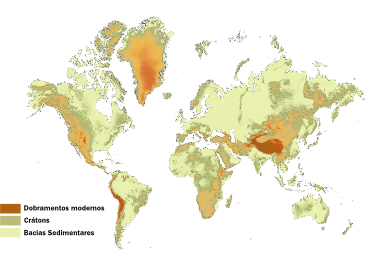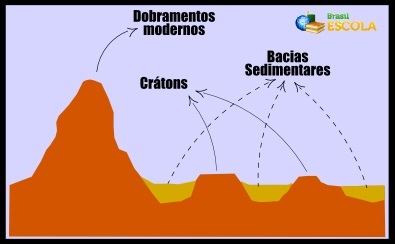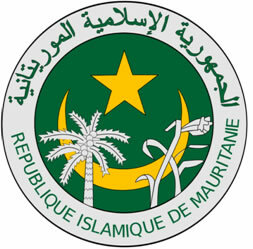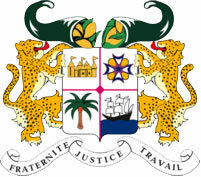The lithosphere – the rock layer of planet Earth – has countless dynamics and variations. Its structural composition, however, is classified into three different types of geological structures that are divided around the world: the cratons (or ancient shields), the sedimentary basins and the modern folding (or orogenic chains).
See below the map of geological structures in the world that demonstrates the presence of different types and their distribution across geographic space:

Geographical distribution of the Earth's geological structures
By observing the map, we can see that the modern folding they are found in areas that have known mountain ranges, such as the Andes Mountains, west of South America; the Rocky Mountains in North America; the Alps in Europe; and the Himalayan Mountains in Asia.
This is because modern folds are, in fact, stretches of recent formation originated by the elevation of the terrain due to the interaction of tectonic plates and resulting phenomena. Brazil, as it has an ancient geological formation, does not have this type of geological structure.
At sedimentary basins, on the other hand, are distributed in different parts of the world, existing also in Brazilian territory. They cover about 75% of the Earth's surface and are characterized by their formation in the Paleozoic Era (500 million years ago above), with the accumulation of sediments generated by the wear of the rocks due to the action of external agents of formation of the relief.
Do not stop now... There's more after the advertising ;)
It is in the sedimentary basins that there is the possibility of an accumulation of oil, as well as the existence of fossils, although this is not something decisive. They commonly form in oceanic areas and transform into continents because of the movement of tectonic plates.
Finally, we have the cratons, which are popularly known as crystal shields and old massifs, names given to its two subtypes. Their formation is the same as modern folding, however, as they are older, they suffered greater wear of external or exogenous agents for the transformation of the relief, the same ones that originated the basins sedimentary The terrain is so old that it has the oldest rocks found on the planet.
Cratons usually cover plateau areas. In Brazil, they cover, for example, the Central Plateau, the Guianas and an area of shields in the Amazon, rich in minerals and which, for this reason, has been the target of offensives by mining companies, which could put the Amazon Forest at risk Equatorial.
Below, we have an illustrative table that presents a synthesis with the three types of geological structures

Explanatory scheme with the different geological structures
By Rodolfo Alves Pena
Graduated in Geography
Would you like to reference this text in a school or academic work? Look:
PENA, Rodolfo F. Alves. "Earth's Geological Structures"; Brazil School. Available in: https://brasilescola.uol.com.br/geografia/estruturas-geologicas-terra.htm. Accessed on June 27, 2021.



